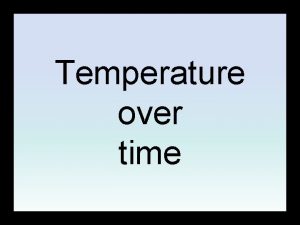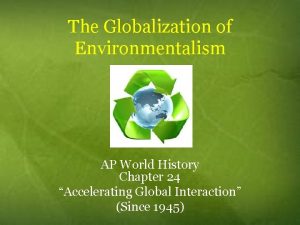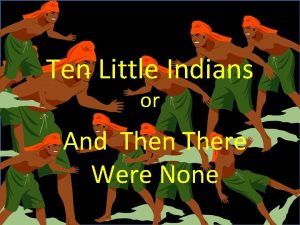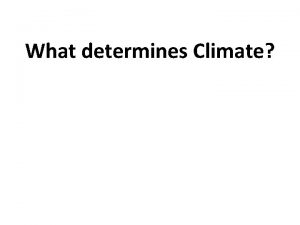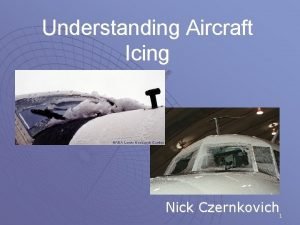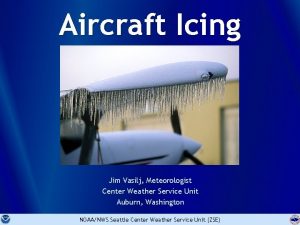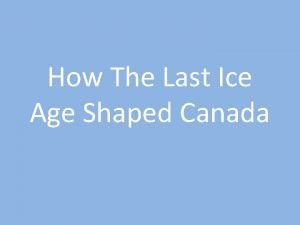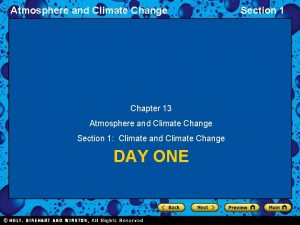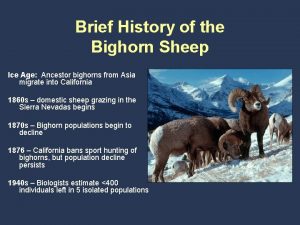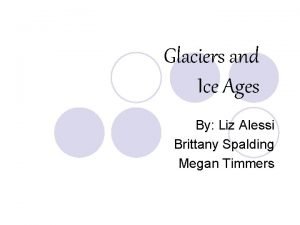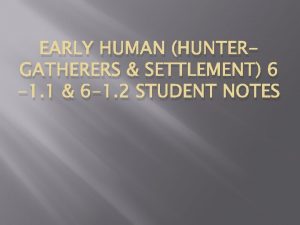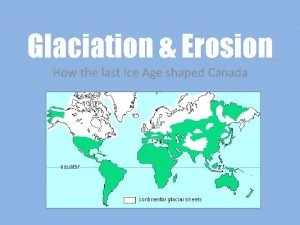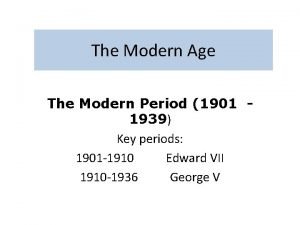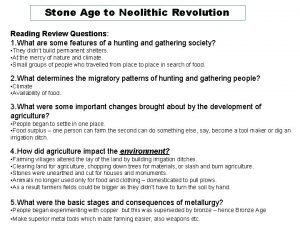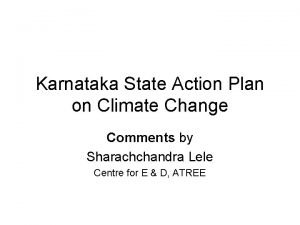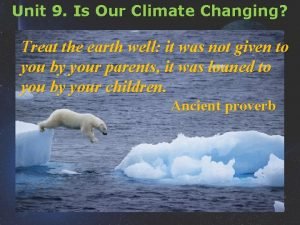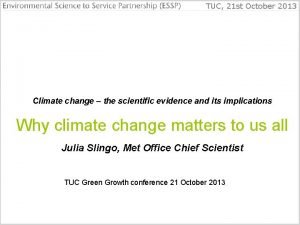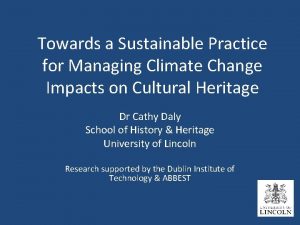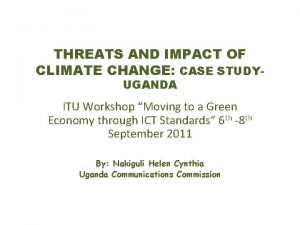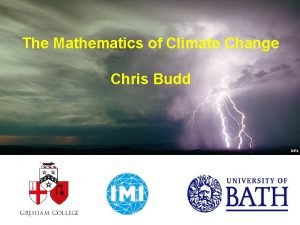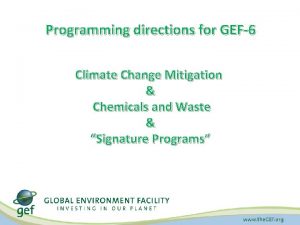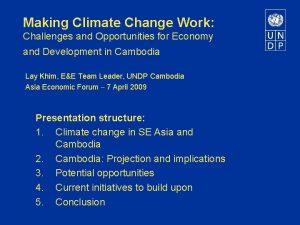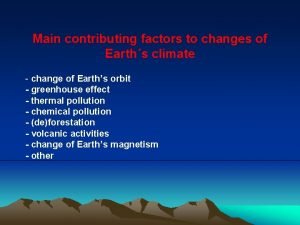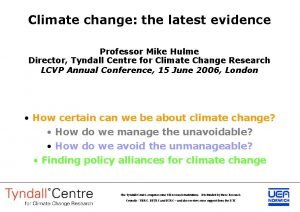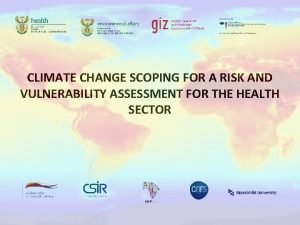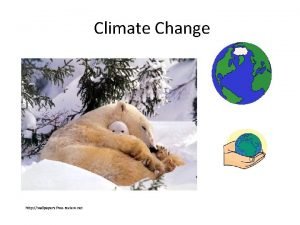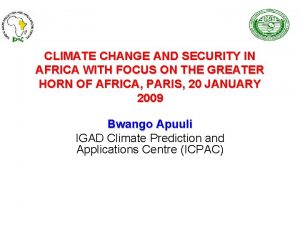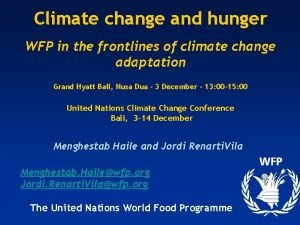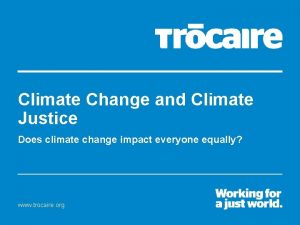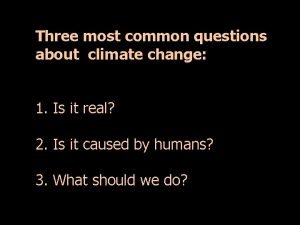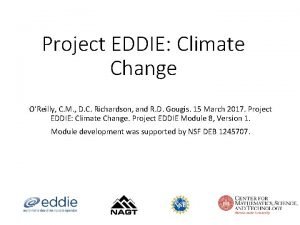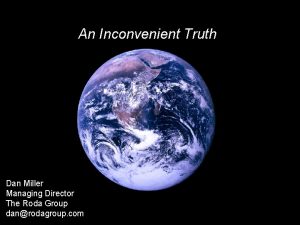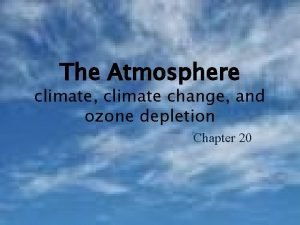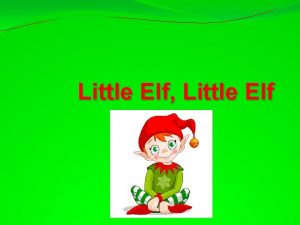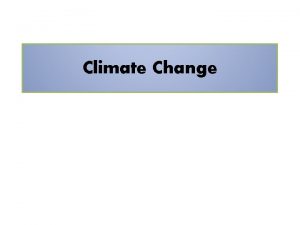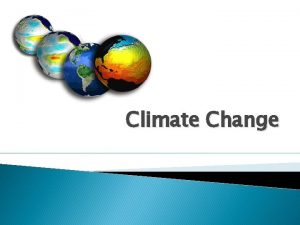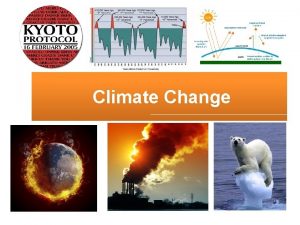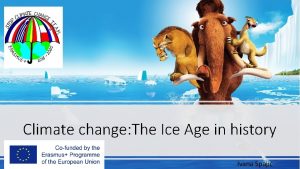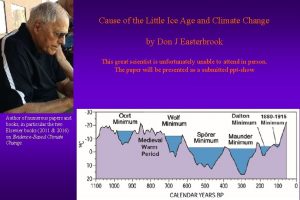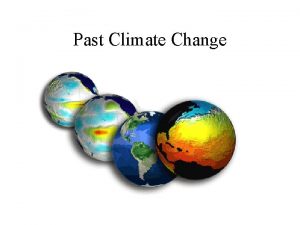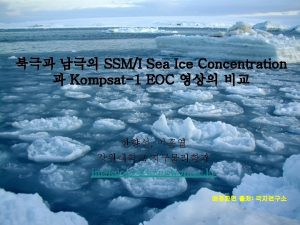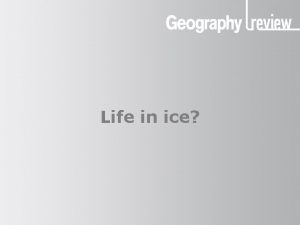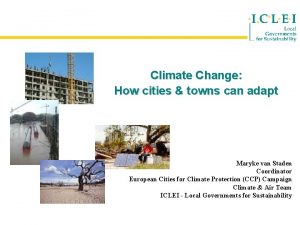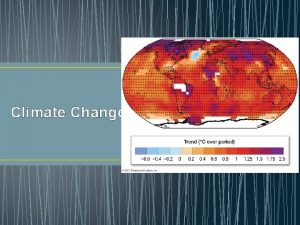Climate change and history The Little Ice Age















































- Slides: 47

Climate change and history The Little Ice Age “some knights who were sitting on a magnificently outfitted horse gave the horse and their weapons away for cheap wine and they did so because they were so terribly hungry”. A German Chronicler in 1315

The last great Ice Age- 110, 000 to 12, 000 years ago (from New Scientist) • Homo Sapiens shared the planet with Neanderthals whom they replaced as the Ice Age neared its worst 20, 000 years ago. Homo Sapiens invented farming as they moved north following the retreating ice. • At the peak of the last Ice Age ocean levels were 120 metres lower than they are today – led to the “out of Africa” movement 60, 000 years ago. Ice covered 30% of the planet then as opposed to 10% today. Temperatures were 5 - 7 C lower than today. • As the glacial period drew to a close and temperatures began to rise, there were two final cold snaps. First, the chilly “Older Dryas” of 14, 700 to 13, 400 years ago transformed most of Europe from forest to tundra, like modern-day Siberia. After a brief respite, the Younger Dryas, between 12, 800 to 11, 500 years ago, froze Europe solid within a matter of months – probably as a result of melt water from retreating glaciers shutting down the Atlantic Ocean’s Conveyor Belt, although a cometary impact has also been blamed. • Waiting for the next one. Are we postponing it with global warming?

The last Ice Age • . . ice_age. mov

The Quaternary glaciation • Compared to conditions on Earth 20, 000 to 30, 000 years ago we are clearly not in an ice age now • But in terms of the long history of the Earth we are actually still in an overarching ice age period - known as the Quaternary glaciation - which has been going for the last 2. 6 million years. At the moment, the Earth is just in a slightly warmer period, an interglacial. • There have been at least four other overarching ice ages in the Earth's history, the oldest started about 2, 400 million years ago. • Lower sea levels (by about 120 metres) during the last Ice Age enabled homo sapiens to leave Africa 60, 000 years ago. • Mini Ice Age from 6200 – 5800 BC. 5000 BC climate and sea levels stabilise in current form. • It is possible that not just the Green house gases over the last 200 years have staved off the next ice age but also the advent of large scale farming that has been going on now for thousands of years.

The Little Ice Age

Preceded by the medieval warming from 950 – 1250 AD • • • Temperatures in Europe were 1 – 1. 5 C warmer than the average. Tree rings. Wine grown in England – which the French tried to exclude from the continent. London had the climate Paris has now. European population explosion due to massive increase in food production. 40 million peasants to 60 million but life expectancy was around 35 – 36 years. 1 in 2 children still die before reaching their first birthday. A precarious existence. Because Europe was an agriculturally based society it lead to prosperity, cathedral building etc. Gothic Cathedrals. Crops could grow 200 metres higher up the valleys in Scandinavia. The Viking expansion – sea ice less of a hindrance to exploration. Farming in Greenland. It was global in scope – even China was affected. Art, Writing and Science flowered. the indigenous peoples of North America pushed their agriculture northward up the Mississippi, Missouri, and Illinois river basins. Humanity prospers under warmer conditions but not too warm.

The Dom in Cologne

What caused the sudden warming? • An increase in solar radiation. • A decrease in volcanic activity. • The ocean circulation patterns shifted to bring warmer seawater into the North Atlantic. • mainly a regional phenomenon caused by altered heat distribution rather than a global phenomenon. Not the same as now as some would suggest. • This pressure difference in turn revealed that the medieval period must have experienced a strongly positive North Atlantic Oscillation (NAO) – the ocean current that drives winds from the Atlantic over Europe. The more positive the NAO is, the more warm air is blown towards the continent.

Life in the great warming

But then the Little Ice Age began 1300 - 1895

The little Ice Age – causes and effects? • Reduced solar radiation. Two solar minimums – reduced sun spot activity coincide with the coldest part of the Little Ice Age. • Planetary wobble? • Snow in the middle of an American summer in 1816. • Increased volcanic activity. Laki in Iceland in 1783 and Tambora in Indonesia in 1815. Gas and ash into the atmosphere where they reflect sunlight. 1816 “the year without summer” – caused by Tambora. Krakatoa – 1883. • Sulphur dioxide becomes sulphuric acid higher up which creates aerosols for years afterwards. • Crop failures led to the start of opium farming in China. • Arctic actually warmed up leading to greater exploration. • Cholera epidemic after Tambora – Frankenstein in Geneva. • Changes in the weather circulatory pattern. Negative NAO – warmer weather moves south and colder Russian air moves in to take its place. Melted fresh water into the North Atlantic slows down the Gulf Stream.

And epic sunsets Chichester canal by J. M Turner

In England the Thames frosted over The last time this happened was in 1804

How does the North Atlantic Oscillation work? • • Westerly winds blowing across the Atlantic bring moist air into Europe. In years when westerlies are strong, summers are cool, winters are mild and rain is frequent. If westerlies are suppressed, the temperature is more extreme in summer and winter leading to heat waves deep freezes and reduced rainfall. (from Wikipedia). A permanent low-pressure system over Iceland (the Icelandic low) and a permanent high-pressure system over the Azores (the Azores high) control the direction and strength of westerly winds into Europe. The relative strengths and positions of these systems vary from year to year and this variation is known as the NAO. A large difference in the pressure at the two stations (a high index year, denoted NAO+) leads to increased westerlies and, consequently, cool summers and mild and wet winters in Central Europe and its Atlantic coast. In contrast, if the index is low (NAO-), westerlies are suppressed, northern European areas suffer cold dry winters and storms track southwards toward the Mediterranean. This brings increased storm activity and rainfall to southern Europe and North Africa. UK winter of 2010 – coldest for 30 years mainly due to high negative

Today’s Pressure chart

The North Atlantic oscillation (NAO)

The Jet stream • Discovered by the Japanese in WW 2 • A narrow river of air between 5 – 10 kms wide. • Can reach speeds of up to 400 km/h. • Moves weather system with it. • To be found at the boundaries of cold and warm air masses. • If it moves south in the northern hemisphere it brings colder weather and vice versa if it moves up from the South. • Erratic

The Thermohaline conveyor – what does it do? • The ocean conveyor gets its “start” in the Norwegian Sea, where warm water from the Gulf Stream heats the atmosphere in the cold northern latitudes. • This loss of heat to the atmosphere makes the water cooler and denser, causing it to sink to the bottom of the ocean. • As more warm water is transported north, the cooler water sinks and moves south to make room for the incoming warm water. • This cold bottom water flows south of the equator all the way down to Antarctica. • Eventually, the cold bottom waters return to the surface through mixing and wind-driven upwelling, continuing the conveyor belt that encircles the globe. • The whole process takes about 1000 years. • The warm current flowing from America to East Africa and Western Europe is called the Gulfstream. It is this warm water that gives Europe it temperate climate and Britain its rain.

The Thermohaline Conveyor

The little Ice Age (1300 – 1850) • Best records are in Europe but it was global. Three main phases. Growth and prosperity of the 11 th to the 13 th Centuries comes to an end. • Food production plummets because of cool winters and wet summers. Cereal crops very vulnerable to 5 years of rain – more suited to benign climate. The great famine from 1315 to 1317 killed off 10% of the populations of some countries. Hansel and Gretel story. • Bad weather in the spring of 1315 – food production did not recover until 1322. High levels of crime, disease, cannibalism. Some populations did not recover until the 19 th century. • The Black Death 1347 – 1351 – people more vulnerable because of hunger. • Pack Ice and storms expand in the 15 th century. Greenland cut off and Iceland eventually cut off as well. • Glaciers wipe out whole villages, farms and churches in France and Switzerland. • 17 th century – cod populations in the Atlantic wiped out. Cod in the Grand Banks – led to the colonisation of America.

Somerset - 2014

The Little Ice Age – other effects • Apart from famine from 1315 – 1322 and the Black Death 1347 1351 there was also. • In China weakened by famine and floods in the 17 th Century the Ming Dynasty is overthrown by peasants unable to pay their taxes and the Manchus rise to power. • In Europe witch trials coincided with the coldest spells – they were blamed for climate change. • 30 years war in Europe between Catholics and Protestants (1614 – 1648) sometimes directly linked to inflated grain prices because of falling agricultural production. • Potatoes come into their own – despite initial reluctance they could withstand the colder temperatures. • Hansel and Gretel. • New England settlers move to the Mid West to escape June snowfalls boosting the expansion westwards.

Other effects - The Black Death • 1347 – 1351 from Central Asia. As Europe becomes wetter, Central Asia becomes drier forcing the Mongols to move looking for pasture. • Bubonic plague – curable only in the first 24 hours today. • Of some 75 million people in Europe some 25 million died. • Lowered resistance after years of hunger. • Imagined causes? Bad Air, God’s punishment, The Jews (massacres) • Actual causes – rats, fleas, dogs, urbanisation, the fleeing flagellants. • Reminders – ring a rosy, abracadabra. • Save yourselves – abandonment, locking up, gifts to churches, bonfires, madness. • After effects, breakdown of the feudal order, trade guilds, improved wages. War also to blame (1337 -1453) • 3000 villages in France abandoned. 90% of the population were peasants who worked just to feed themselves.

And hunger • An absence of cider or beer meant that more people had to drink water and a s result the death tally rose. • Glaciers threaten alpine communities. • The Great storm of 1588 sinks and scatters the Spanish Armada. • 1590 s – Tudor England at risk of food riots. 3 or 4 good harvest years were usually followed by the same bad ones. Hoarders denounced to little avail. No means of moving grain about to alleviate the problem. • 1607 – the winter so severe that frost splits trees in two. • 4 major cold snaps in the 17 th century due to volcanic activity. • Late 17 th Century – the Maunder sunspot minimum created vicious winters.

The Rhone Valley Glacier 1856 - 2008

Safeguard - The farming revolution starts in Holland • Three field system – Dutch abandoned and used the fallow field to grow forage crops for animals. Peas, beans, clover and turnips. • More meat, wool, manure and leather came on to the market. • Land reclamation using wind powered windmills. • The arrival of the market garden using animal manure. Cabbages, cauliflower, peas and carrots in London by 1600. • Started in the 15 th Century in Flanders and Holland but did not reach England until the 17 th and 18 th centuries. France later still. England copies Dutch land reclamation in the Fens in eastern England • Dutch introduce the cold resistant turnip to England – the tops often used as a substitute for hay. • From 1650 most realised that larger farms would break the back of subsistence farming but not necessarily famine. Farms became larger and more specialised.

The Three field system

Heures de notre Dame 15 C and Van Gogh Harvester 1885

The arrival of the potato • • • First brought back by the Spanish in 1570. Prevented scurvy, made for quick and cheap meals Easy to plant and harvest. Most people in Europe thought them exotic and probably poisonous. Not Gentlemen’s food 1700 - England potatoes grown for animal feed, then the poor and eventually everyone else. Spread to Ireland with disastrous consequences because of the Tumbler blight. • As late as 1750 France resisted the potato – suggested it caused leprosy and shunned by gourmands.

The great change - The Columbian exchange

More like winter than summer • London 1665 – 57, 000 die in the plague. • 1666 – cold winter followed by hot summer – the great fire. House to be made of brick and stone in the future. 100, 000 out of 600, 000 homeless. • 1680 – 1700 very cold winters and cool summers in England France. • 1696 - 1697 Finland loses 1/3 rd of its population to famine and disease. • 1740 - bitter winter people froze to death – poor heating in most houses even the grand ones. • Accident hypothermia – shivering. Once body gets below 35 C the body stops shivering, heart rate slows, blood pressure drops – cardiac arrest. • Famine also caused diarrhoea, dysentery and typhoid. • Growth of enclosures meant no more commons for animals. Move to the hovels of the cities for work at the start of the Industrial evolution. Poor diet. People actually get shorter by 5 cm on average between

World War 1

Revolution in France • French fail to modernise as England Holland had – turned up noses at potatoes. Cereal crops to eat and vines to sell. • 1670 – 1700 cooler years and wars led to food shortages. • Famine of 1693 – 1694 – 10% of France died while Louis XIV was at Versailles. • 1740 – Paris has 75 days of frost. • 1770 s poor harvests – seed crops used. • 1784 - Laki erupts • 1788 - beggars roam in gangs intimidate farmers. Rural Crime – storms force King into a farmhouse. • 1789 – bread riots – military escorts for food wagons. July 14 the Bastille is stormed. • As the 18 th century drew to a close, two decades of poor cereal harvests, drought, cattle disease and skyrocketing bread prices had kindled unrest among peasants and the urban poor in France. The French Revolution of 1789.

The winter of 1695

The winter of 1695 – crop failures 8 out of 10 years

Volcanoes • 1815 – Tambora in Indonesia erupts. The biggest ever since Santorini. • Larger than Krakatoa (1883) which reduced sunlight in Europe by 20 – 22%. • Extreme volcanicity – 3 majors between 1812 – 1815 and again between 1835 – 1841. • 1816 - the year without summer. Wheat yields plummet at a time when food and drink = 2/3 rds of the family budget. • Percy and Mary Shelley in Geneva – Frankenstein. • End of the world movements. Crime and law and order breakdown and massive Emigration from the Europe to the US. • Last of the great famines ads canal and rail links make food distribution quicker and easier Ireland the exception • Potato blight on lumper potatoes in 1846. 9 million died – 2. 5 million emigrated, Britain did nothing to help. • 1895 – 1940 – mild summers.

1816 – the year without summer


A warmer period – the green house effect • Growing seasons in Northern Europe will lengthen as they will in Canada • Tropical Africa will be hit hard as will South America. • Greater conflict over water rights. • Siberia the new breadbasket? Permafrost could retreat by 160 km by 2050. . Better off than Canada which lost a lot of topsoil to Pleistocene glaciers. • Or will it become a watery boggy mess leaking massive amounts of methane into the atmosphere. • Warming causing health problems, problems for gas pipelines. No longer a protective barrier? • Water quality will be affected by temperature changes. • Chad and its neighbours worst affected. Best place to be – Alaska? Or perhaps the Scandinavian countries. • Coastal cities under threat as sea levels rise.

Will the warm age be followed by another ice age? • The Gulf stream gives Europe its milder climate. • In the past, the slowing of the Gulf Stream has been intimately linked with dramatic regional cooling. Just 10, 000 years ago, during a climatic cold snap known as the Younger Dryas, the current was severely weakened, causing northern European temperatures to fall by as much as 10 degrees. • Ten thousand years before that, at the height of the last ice age, when most of the UK was reduced to a frozen wasteland, the Gulf Stream had just two-thirds of the strength it has now. • The Gulf Stream could be seriously affected, as a result of largescale melting of Arctic ice and the consequent pouring of huge volumes of fresh water into the North Atlantic, in a century or two. • Outflow from Nordic waters in the THC is already 20% down since 1950. • another ice age is not likely to occur for thousands of years. Anywhere between 5000 and 45, 000 years is a possibility.

The Thermohaline Conveyor

From reviews of “The Long Summer” • The Earth's climate shaped the ancient Egyptian civilisation by turning the Sahara, once relatively wet and benign, into desert, compressing life to the margins of the Nile. It destroyed the Mayans through drought in 900 BC; blessed both Romans and Vikings with warm, prosperous climates; and freed the ice-covered Siberia. Alaska land bridge around 12, 000 BC, so Asians could cross and colonise America. • Lake Agassiz, a massive body of water formed by melt waters from the Laurentide ice shield that then covered much of North America, began to swell as the Earth's climate got hotter. Inevitably, it broke its banks some 13, 000 years ago, sending a vast inundation of glacial melt water surging down the St Lawrence river. • For months, the freezing deluge poured into the Labrador Sea. 'Like an electric switch, Lake Agassiz's fugitive waters turned off the Atlantic conveyor belt, • The warming waters of the Gulf Stream were severed and the world plunged into a mini-Ice Age.

Lake Agassiz

A hot or cold future? • Glacial and interglacial periods cause by changes in the Earth’s orbit around the sun. • No ice age for at least 5000 years and with global warming may be postponed for 45, 000 years. • But regional changes of 5 C can be achieved in decades rather than thousands of years. • Warming occurs faster than cooling. • Since 1 million years go ice ages occurred every 100, 000 years. Our present Holocene period started 10, 000 years ago when the glaciers retreated. • Both poles re still glaciated now –a rare occurrence in history. Temp differences between +30 C at the Equator and -35 C at the Poles drives our weather. Warming makes that even more volatile.

Reading guide

And in the movies

And a salutary overview
 Climate change 2014 mitigation of climate change
Climate change 2014 mitigation of climate change 5 major ice ages
5 major ice ages Stone age, bronze age iron age timeline
Stone age, bronze age iron age timeline Iron age bronze age stone age timeline
Iron age bronze age stone age timeline Environmentalism definition ap world history
Environmentalism definition ap world history 1 little 2 little 3 little indians
1 little 2 little 3 little indians 1 little 2 little 3 little indian
1 little 2 little 3 little indian What determines climate
What determines climate Icing
Icing Clear ice vs rime ice
Clear ice vs rime ice When did the last ice age start and end
When did the last ice age start and end Climate change meaning and definition
Climate change meaning and definition Atmosphere
Atmosphere Chapter 13 atmosphere and climate change
Chapter 13 atmosphere and climate change Ice age sheep
Ice age sheep Liz alessi
Liz alessi Scrat s continental crack up
Scrat s continental crack up Ice age migration
Ice age migration Ice age period
Ice age period Victorian age and modern age
Victorian age and modern age Difference between stone age and modern age
Difference between stone age and modern age Romantic and victorian age
Romantic and victorian age Persuasive essay about global warming
Persuasive essay about global warming Karnataka state action plan on climate change
Karnataka state action plan on climate change How many major climate types are there worldwide brainpop
How many major climate types are there worldwide brainpop Unit 9 climate change
Unit 9 climate change Conclusion of climate change
Conclusion of climate change Youreuropemap.com
Youreuropemap.com Conclusion of climate change
Conclusion of climate change Mathematics of climate change
Mathematics of climate change Climate change mitigation
Climate change mitigation 414 climate change
414 climate change Conclusion of climate change
Conclusion of climate change Factors of climate change
Factors of climate change Human causes of climate change
Human causes of climate change Theoretical framework example
Theoretical framework example Uk climate change
Uk climate change Climate change interview
Climate change interview Factors that affect climate change
Factors that affect climate change Conclusion of climate change
Conclusion of climate change Conclusion of climate change
Conclusion of climate change Climate change causing droughts
Climate change causing droughts Climate change hypothesis
Climate change hypothesis Project eddie climate change
Project eddie climate change Financing education in a climate of change
Financing education in a climate of change Climate change pathos
Climate change pathos Dan miller climate change
Dan miller climate change Un climate change
Un climate change

